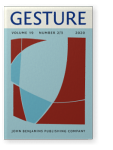Vol. 19:2/3 (2020) ► pp.269–298
Why do we shake our heads?
On the origin of the headshake
This article discusses several arguments in favor of the hypothesis that the headshake as a gesture for negation has its origins in early childhood experiences. It elaborates on Charles Darwin’s observation that children inevitably shake their heads in order to stop food intake when sated, thereby establishing a connection between rejection and the head gesture. It is argued that later in life the semantics of the headshake extends from rejection to negation – just as it can be observed in the development of spoken language negation. While Darwin’s hypothesis can hardly be tested directly, this paper takes a novel perspective and looks at the predictions it makes taking a plethora of sources of evidence into account. The question of how head gestures are used in cultures where the headshake is not a sign for negation or where other negative head gestures are in use will also be discussed.
Article outline
- 1.Introduction
- 2.Darwin’s hypothesis and its predictions
- 3.Prediction I: The prevalence of the negative headshake
- 3.1Different head movement systems
- 3.2The distribution of the systems
- 3.2.1Headshakes in spoken languages with System A
- 3.2.2Headshakes in sign languages
- 3.2.3Headshakes in alternate sign languages
- 3.2.4Headshakes in spoken languages with System B and C
- 4.Prediction II: Early acquisition of the headshake
- 5.Prediction III: Headshakes in humans born deaf-and-blind
- 6.Prediction IV: Headshakes of other mammals
- 7.Conclusions
- Notes
-
References
